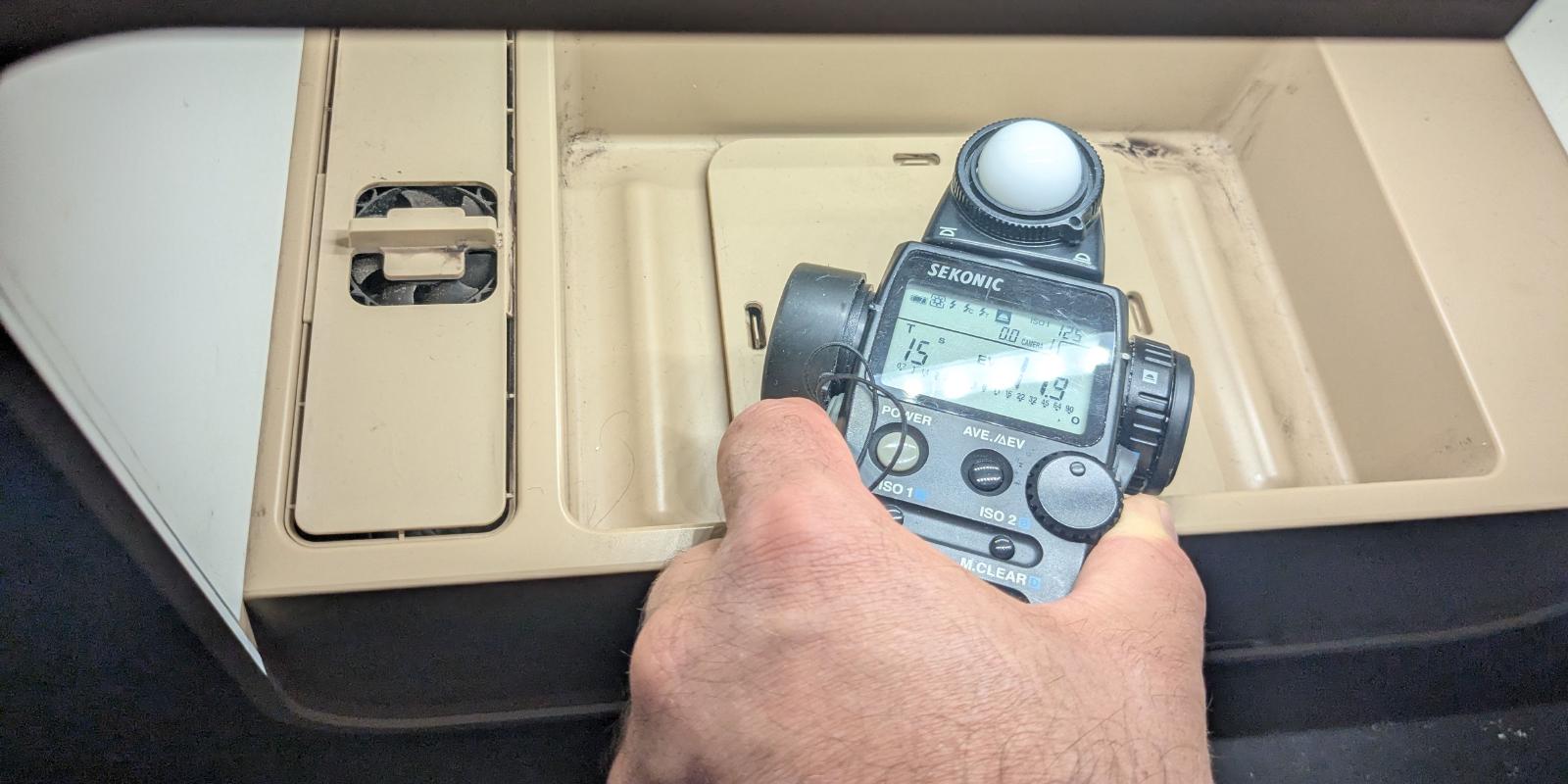Shrooly Mushroom Device Teardown
Introduction I recently (after a very long wait) received my Shrooly Mushroom Growing Device. It seems to work pretty well and produced a few crops of tasty mushrooms before failing with a …
If you’re using a Shrooly mushroom growing device and trying to follow growing guides from online mycology resources, you’ve probably noticed they specify light requirements in lux while Shrooly only gives you LED brightness percentages. This post explains how to convert between the two based on actual measurements.
Many mushroom growing resources specify light requirements in lux, but Shrooly only lets you control “White LED brightness” as a percentage from 0-100%. Without knowing the relationship between these values, it’s difficult to follow external growing guides precisely.
I measured the exposure value (EV) inside a Shrooly cavity using a Sekonic L-758DR light meter at various LED brightness levels, then converted to lux using the standard formula:
$$\text{Lux} = 2.5 \times 2^{\text{EV}}$$
(The Cine versions of my meter can do Lux directly, but they cost more and i’m not buying another one for this project!)
Here’s what I found:
| LED Brightness (%) | EV | Lux |
|---|---|---|
| 100 | 11.7 | 8,317 |
| 90 | 11.2 | 5,881 |
| 80 | 10.7 | 4,159 |
| 70 | 10.2 | 2,941 |
| 60 | 9.6 | 1,940 |
| 50 | 8.8 | 1,114 |
| 40 | 7.9 | 597 |
| 30 | 6.9 | 299 |
| 25 | 6.1 | 171 |
| 20 | 5.2 | 92 |
| 18 | 4.2 | 46 |
| 15 | 2.1 | 11 |
| 12 | 0.09 | 2.7 |
| 10 | 0.0 | 2.5 |
 The relationship between Shrooly’s LED brightness percentage and lux follows a power law, with a sharp drop-off below 20% brightness
The relationship between Shrooly’s LED brightness percentage and lux follows a power law, with a sharp drop-off below 20% brightness
I used a mix of ChatGPT and check out the Python to figure out the relationship. At first I was hoping it’d be really simple but there’s a sharp dropoff as the brightness level drops below 20% so I ended up needing two different functions.
$$\text{Lux} \approx 0.442 + 7.383 \times 10^{-8} \times \text{Brightness}^{6.991}$$
$$\text{Lux} \approx 0.02307 \times \text{Brightness}^{2.768}$$
 The piecewise fit model (red line) closely matches the measured data points (blue), with different formulas for low (≤20%) and high (>20%) brightness ranges
The piecewise fit model (red line) closely matches the measured data points (blue), with different formulas for low (≤20%) and high (>20%) brightness ranges
I’m in the process of adding this to an OpenShrooly release that will change the white light setting to be in LUX and not a set percentage, but this requires inverting the formulas to convert from desired lux to LED brightness percentage. This should show up in the 0.4.3 release.
For the low light range (≤92 lux, which corresponds to ≤20% brightness):
For the higher light range (>92 lux):
Here’s how this looks in code (C++ for ESPHome):
float lux_to_brightness(float lux) {
if (lux <= 0) {
return 0.0f;
}
// Low light range: 0-92 lux maps to 0-20% brightness
if (lux <= 92.0f) {
return (lux / 92.0f) * 20.0f;
}
// Higher light range: use inverse power law
float brightness = pow(lux / 0.02307f, 1.0f / 2.768f);
// Clamp to 100%
return min(brightness, 100.0f);
}
With this implementation, the OpenShrooly interface will show a slider from 0-4000 lux (capped at a reasonable maximum), making it much easier to follow mushroom growing guides that specify light requirements in lux rather than arbitrary percentages.
All measurements above were taken at 135mm below the LEDs, which is approximately where mushroom pins form. However, as mushroom caps develop and grow upward, they get closer to the LEDs and receive significantly more light due to the inverse square law.
Using the inverse square law:
$$L_{\text{height}} = L_{135\text{mm}} \times \left(\frac{135}{d}\right)^2$$
Here’s how the light intensity changes at different heights for some common settings:
| Height from LEDs | Distance Factor | 30% Setting | 40% Setting | 50% Setting |
|---|---|---|---|---|
| 135mm (pins) | 1.0× | 299 lux | 597 lux | 1,114 lux |
| 100mm (young fruits) | 1.8× | 545 lux | 1,089 lux | 2,032 lux |
| 75mm (mid growth) | 3.2× | 968 lux | 1,935 lux | 3,610 lux |
| 50mm (mature caps) | 7.3× | 2,184 lux | 4,367 lux | 8,145 lux |
| 35mm (tall caps) | 14.9× | 4,455 lux | 8,909 lux | 16,611 lux |
Now the typical 10-20% brightness range in Shrooly programs makes perfect sense:
| Brightness | Lux at Pins (135mm) | Lux at Mature Caps (50mm) | Lux at Tall Caps (35mm) |
|---|---|---|---|
| 10% | 2.5 lux | 18 lux | 37 lux |
| 15% | 11 lux | 80 lux | 164 lux |
| 20% | 92 lux | 672 lux | 1,371 lux |
These lower settings work because:
Default Settings: Start with 100-200 lux (roughly 15-20% brightness) for most species
Species-Specific Ranges:
Adjust for growth patterns:
Watch for signs:

